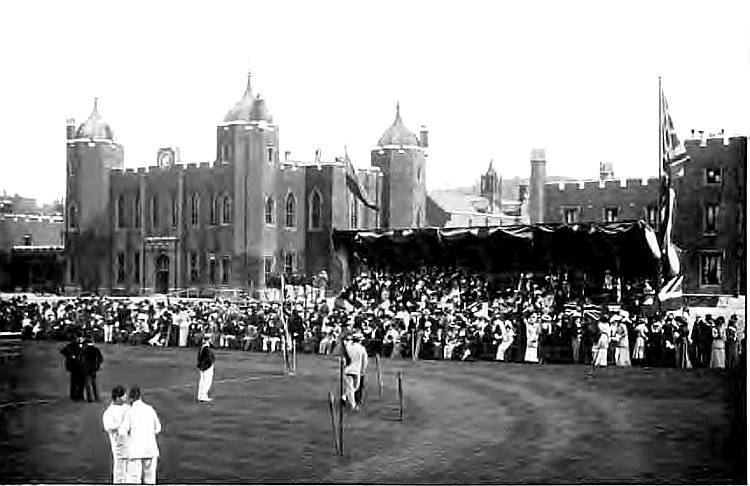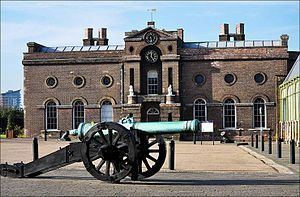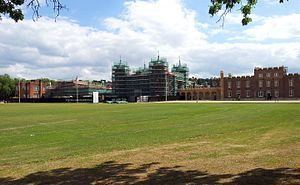Active 1741–1939 Type Training Ceased operations 1939 Role Officer training | Country United Kingdom Founded 1741 | |
The Royal Military Academy (RMA) at Woolwich, in south-east London, was a British Army military academy for the training of commissioned officers of the Royal Artillery and Royal Engineers. It later also trained officers of the Royal Corps of Signals and other technical corps. RMA Woolwich was commonly known as "The Shop" because its first building was a converted workshop of the Woolwich Arsenal.
Contents
- Origins in the Royal Arsenal
- Relocation to Woolwich Common
- Closure and aftermath
- Sale and redevelopment
- Education and training
- Architecture
- Slang
- Commandants
- Notable teachers
- References

Origins in the Royal Arsenal

An attempt had been made by the Board of Ordnance in 1720 to set up an academy within its Arsenal (then known as the Warren) to provide training and education for prospective officers of its new Regiment of Artillery and Corps of Engineers (both of which had been established there in 1716). A new building was being constructed in readiness for the Academy and funds had been secured, seemingly, through investment in the South Sea Company; but the latter's collapse led to plans for the Academy being placed on hold.

After this false start, the Academy was opened by authority of a Royal Warrant in 1741: it was intended, in the words of its first charter, to produce "good officers of Artillery and perfect Engineers". Its 'gentlemen cadets' initially ranged in age from 10 to 30; they were accommodated in lodgings in the town of Woolwich to begin with, but this arrangement was deemed unsatisfactory (the cadets gained a reputation for riotousness) so in 1751 a Cadets' Barracks was built just within the south boundary wall of the Warren and the cadets had to adjust to a more strict military discipline. (The Cadets' Barracks was demolished in the 1980s for road widening.)

Education in the Academy focused at first on mathematics and the scientific principles of gunnery and fortification. French was also taught, for a small fee. In the 1760s the Military Academy acquired its Royal title. At the same time the institution was split: younger cadets entered the Lower Academy, where they were taught reading, writing, arithmetic, Latin, French and drawing. If they performed well in examinations they were allowed to proceed to the Upper Academy, where they learned military skills and sciences (as well as fencing and dancing – required skills for prospective officers).
Relocation to Woolwich Common

The possibility of moving the Royal Military Academy out of the Warren was mooted as early as 1783, as it was fast outgrowing the available accommodation. At first costs precluded this possibility, but (with the Academy continuing to grow) James Wyatt, the Board of Ordnance Architect, was commissioned to design a new complex of buildings to stand, on a site facing the Royal Artillery Barracks, at the southern edge of Woolwich Common; it was built between 1796 and 1805 and opened for use the following year.

Wyatt's Academy was built of yellow brick in the Tudor Gothic style. It consisted of a central block (reminiscent of the Ordnance Board's headquarters in the Tower of London) flanked by a pair of accommodation blocks, linked by arcaded walkways. The central block contained classrooms, a library and offices; the accommodation blocks housed officers in the three-storey central sections and cadets in the two-storey wings. Behind the central block Wyatt placed a large dining hall flanked by spacious quadrangles having service buildings around the sides.
128 cadets moved to the new Academy: these comprised the four senior years. Of the younger cadets, sixty were kept at the Warren (by then renamed the Royal Arsenal) and another sixty were sent to a new college for junior cadets at Great Marlow. Practical teaching continued to be given in the working context of the Arsenal. In 1810, military cadets of the East India Company, who had previously been educated at the Academy, were moved to a new college at Addiscombe.
During the years that followed the status of the cadets changed: rather than being considered (albeit junior) military personnel, as had previously been the case, they were removed from the muster roll and they (or their parents) began to be charged fees for attendance. In this way the Academy took on something of the ethos of an English public school. In 1844 the Academy was described by Edward Mogg as accommodating:
"about one hundred and thirty young gentlemen, the sons of military men, and the more respectable classes, who are here instructed in mathematics, land-surveying, with mapping, fortification, engineering, the use of the musket and sword exercise, and field-pieces; and for whose use twelve brass cannon, three-pounders, are placed in front of the building, practising with which they acquire a knowledge of their application in the field of battle. This department is under the direction of a lieutenant-general, an instructer, a professor of mathematics, and a professor of fortification; in addition to which there are French, German, and drawing masters".Following the demise of the Board of Ordnance in the wake of the Crimean War the Academy was inspected by a commission which recommended changes: the minimum age for cadets was raised to fifteen and more specialist training was added. As part of these reforms the Academy complex was enlarged in the 1860s, with a view to accommodating all cadets on the same site (although some would remain in the Arsenal through to the 1880s): the frontage was extended with the addition of new pavilions at either end, in similar style to Wyatt's work but in red brick rather than yellow; William Jervois was the architect. These contained new classrooms, with accommodation provided in similar new blocks behind. Sports facilities were also added along with gun batteries for training. In 1873 Wyatt's central block had to be entirely rebuilt following a devastating fire.
Closure and aftermath
Following the demise of the Board of Ordnance, Parliament had explored the possibility of a merger between the Royal Military Academy and the Royal Military College, Sandhurst (which only trained officers for the Infantry and Cavalry); although senior Army officers rejected the idea at the time it persisted into the twentieth century. Arguments in favour of a merger gained momentum in the 1920s when the specialist and scientific training which had been Woolwich's preserve began to be outsourced to other locations. In 1936 it was decided that the merger should take place; but the Second World War intervened and in 1939 both institutions closed as their cadets were called up for active service.
The Royal Military Academy Woolwich closed in 1939 and in 1947 the Royal Military Academy Sandhurst was formed on the site of the former Royal Military College with the objective of providing officer training for all arms and services.
Thereafter, the old Academy site became part of Woolwich Garrison, housing troops of various types in the years that followed. The central block was taken over by the Royal Artillery Institution and housed a museum, archives and offices. The chapel (added in 1902) became the Garrison Church (replacing the bombed out Garrison Church of St George). In this way the old Academy continued in military use through the 20th century, but with the number of personnel based in Woolwich having steadily decreased, the site was in 2002 declared surplus to requirements.
Sale and redevelopment
Durkan Group bought the Woolwich site by public tender in 2006 and redevelopment started in 2008. The Woolwich buildings, several of which are grade II listed, are now being converted and extended into 334 houses and apartments, including 150 for a housing association. In 2017 the scaffolding around the main facade has been removed and refurbishment is nearing completion.
Since 2013 the RMA cricket field, one of the oldest in the UK, is being used again by the 3rd and 4th team of Blackheath Cricket Club.
Education and training
Until 1870 prospective officers in the British Army had for the most part to purchase their commissions, and education or training was not seen as a requirement for the rôle. The Board of Ordnance's establishment of a Military Academy represented a very different approach, whereby training and education were obligatory for aspiring officers of its corps, and promotion was offered according to merit (those with highest achievement in their exams being given the first choice of opportunities).
Architecture
The main Academy buildings are described by Historic England as "an outstanding example of Wyatt's Gothick style, and one of the most important pieces of military architecture in the country".
Slang
A phrase said to have entered common parlance from the Academy is "talking shop" (meaning "to discuss subjects not understood by others").
The name of the cue game "snooker" (reputedly invented by a former cadet of the Academy) is said to derive from a slang term for newly arrived cadets: the French term "les neux", which was later corrupted into "snooks".
Commandants
Commandants have included:
Notable teachers
Notable teachers at Woolwich include (in alphabetical order by surname):
